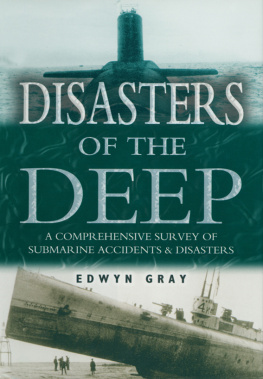Fire at Sea
Other Naval History Titles from Potomac Books:
USS Los Angeles: The Navys Venerable Airship and Aviation Technology William F. Althoff
USS Ranger: The Navys First Flattop from Keel to Mast, 1934-46 Robert J. Cressman
The Liberty Incident: The 1967 Israeli Attack on the U.S. Navy Spy Ship A. Jay Cristol
Cold War Submarines: The Design and Construction of U.S. and Soviet Submarines Norman Polmar and K. J. Moore
War in the Boats: My WWII Submarine Battles William J. Ruhe
Fire at Sea
The Tragedy of the Soviet Submarine Komsomolets
D. A. Romanov
Edited by K. J. Moore
Translated by Jonathan E. Acus

Copyright 2006 by D.A. Romanov.
Published in the United States by Potomac Books, Inc. All rights reserved. No part of this book may be reproduced in any manner whatsoever without written permission from the publisher, except in the case of brief quotations embodied in critical articles and reviews.
Library of Congress Cataloging-in-Publication Data
Romanov, D. A. (Dmitrii Andreevich)
[Tragediia podvodnoi lodki Komsomolets. English]
Fire at sea : the tragedy of the Soviet submarine Komsomolets / D.A.
Romanov ; edited
by K.J. Moore ; translated by Jonathan E. Acus.1st ed.
p. cm.
Includes bibliographical references and index.
ISBN 1-57488-426-3 (alk. paper)
1. Komsomole (Submarine) 2. Submarine disastersNorwegian Sea. I. Moore, Kenneth J., 1942
VA575.K66R6613 2006
910.916324dc22
2005054496
Printed in the United States of America on acid-free paper that meets the American National Standards Institute Z39-48 Standard.
Potomac Books, Inc.
22841 Quicksilver Drive
Dulles, Virginia 20166
First Edition
10 9 8 7 6 5 4 3 2 1
Contents
Illustrations
Editors Preface
Fire at Sea is more than a review of the events leading to the loss of a nuclear submarine. It is more than a series of arguments presented by a ship designer in defense of his work. It is more than a sequential set of case studies that demonstrate the risk incurred when procedure is not well-established and operator training is not a sufficient priority. It is more than an examination of the confused and split responsibilities of a Ministry of Defense and a Ministry of Shipbuilding. It is more than the accusation that a bureaucracy was intent on obfuscating facts to avoid personal responsibility and that it did so without concern for the reoccurrence of such tragedies. In the aggregate, this book addresses the responsibility and risk incurred when operating at the frontiers of technology. History has demonstrated that accidentswhether related to a bridge, a space shuttle, or a nuclear submarinecan provide the insight necessary to enhance the safety and performance of current and subsequent designs. To squander such opportunities is to condemn future generations to further failure. Indeed, in his prophetic postscript to the first edition, the author warned that people would continue to die and ships would continue to sink unless the Russian Navy faced up to its responsibilities.
It is arguable that the success of the bureaucracy to obfuscate the poor level of training focused attention away from this important aspect of safe operations. While the loss of Komsomolets was a series of events initiated by an electrical fire, the loss of the cruise missile submarine Kursk eleven years later (July 2000) was apparently initiated by the crews handling of a torpedo with a potentially unstable propulsion system. Events on the Kursk proceeded rapidly in comparison to the Komsomolets. But loss of the Komsomolets in 1989 could have been a useful warning that training aboard Soviet nuclear submarines was not always up to the level necessary for safe operation. Unbiased reviews of past accidents must address the operation as well as the design of technically demanding systems. The inability to address both the man and the machine simultaneously can condemn an organization to continued catastrophes. This book is replete with descriptions of crew responses that demonstrate a lack of knowledge of critical ship systems, including the life-saving equipment. But the apparent unwillingness to address these training issues squandered an eleven-year opportunity to aggressively improve the training and performance level of the crewmen tasked with the safe operation of submarines.
Romanov is not alone in his frustration with the lack of continuous training and qualification, particularly for newer crewmembers, i.e., those not trained during the construction and acceptance of the ship. During personal discussions, designers from other bureaus and high-level technical naval officers often vent their frustration with regard to the crews unfamiliarity with equipment, including safety circuits and emergency procedures. To them, the solution is to remove the crewmen from the loop completely. On the other hand, the U.S. Navy looks to the crew to improve safety. As Romanov points out in his conclusion, the U.S. Navy openly states that training is its number one priority.
While less obvious, failure also offers the opportunity to recognize more successful approaches. Successful approaches rarely draw the attention that failure brings. Indeed, success can often result in relaxing well-established and proven standardsin both man and technologyto the point that a failure occurs in what once had been a well-tested and well-operated system. Thus, it is just as important to recognize successful systems and insist that the designs and organization not be altered to the point that success can no longer continue.
The U.S. Navys nuclear submarine program is an example of such a success. Navy nuclear trained personnel and, in particular, naval nuclear submariners, are certainly among the best technically trained personnel in the world. The legacy of Admiral Hyman G. Rickover is a self-regulating, introspective organization that has responsibility for the safety, development, operation, and security of naval nuclear reactors. In this case there is no division of responsibility. The integration of man and machine is a continuous and centralized process controlled by personnel who have a lifetime of experience in and commitment to all aspects of the program. The importance and value of such an organization often goes unrecognized, even after the occurrence of the tragic events presented in this text.
The real value of Fire at Sea may be to underscore the importance of successful organizations and to appreciate the value of a society that allows such open examination of technological failures, as demonstrated by the recent investigations into the loss of the space shuttle Columbia. For these reasons, we applaud the openness of the Peoples Republic of China in announcing the death of the seventy-man crew of a MING-Class diesel submarine. It is with sincere concern for all brother submariners that we hope tragedy is being followed by an objective examination of possible failures in both design and training, which then leads to meaningful improvements in crew safety for all cutting-edge manned platforms.
K. J. Moore

Preface
On April 7, 1989, an accident occurred aboard the Soviet nuclear-powered submarine
Next page










